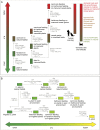Ancestors of domestic cats in Neolithic Central Europe: Isotopic evidence of a synanthropic diet
- PMID: 32661161
- PMCID: PMC7395498
- DOI: 10.1073/pnas.1918884117
Ancestors of domestic cats in Neolithic Central Europe: Isotopic evidence of a synanthropic diet
Abstract
Cat remains from Poland dated to 4,200 to 2,300 y BCE are currently the earliest evidence for the migration of the Near Eastern cat (NE cat), the ancestor of domestic cats, into Central Europe. This early immigration preceded the known establishment of housecat populations in the region by around 3,000 y. One hypothesis assumed that NE cats followed the migration of early farmers as synanthropes. In this study, we analyze the stable isotopes in six samples of Late Neolithic NE cat bones and further 34 of the associated fauna, including the European wildcat. We approximate the diet and trophic ecology of Late Neolithic felids in a broad context of contemporary wild and domestic animals and humans. In addition, we compared the ecology of Late Neolithic NE cats with the earliest domestic cats known from the territory of Poland, dating to the Roman Period. Our results reveal that human agricultural activity during the Late Neolithic had already impacted the isotopic signature of rodents in the ecosystem. These synanthropic pests constituted a significant proportion of the NE cat's diet. Our interpretation is that Late Neolithic NE cats were opportunistic synanthropes, most probably free-living individuals (i.e., not directly relying on a human food supply). We explore niche partitioning between studied NE cats and the contemporary native European wildcats. We find only minor differences between the isotopic ecology of both these taxa. We conclude that, after the appearance of the NE cat, both felid taxa shared the ecological niches.
Keywords: paleoecology; stable isotopes; synanthropic species; trophic niche; wildcat.
Copyright © 2020 the Author(s). Published by PNAS.
Conflict of interest statement
The authors declare no competing interest.
Figures




Comment in
-
Cats as predators and early domesticates in ancient human landscapes.Proc Natl Acad Sci U S A. 2020 Aug 4;117(31):18154-18156. doi: 10.1073/pnas.2011993117. Epub 2020 Jul 20. Proc Natl Acad Sci U S A. 2020. PMID: 32690714 Free PMC article. No abstract available.
References
-
- Zeder M. A., The domestication of animals. J. Anthropol. Res. 68, 161–190 (2012).
-
- Vigne J. D., The origins of animal domestication and husbandry: A major change in the history of humanity and the biosphere. C. R. Biol. 334, 171–181 (2011). - PubMed
-
- Russell N., The wild side of animal domestication. Soc. Anim. 10, 285–302 (2002).
-
- Bateman P. W., Fleming P. A., Big city life: Carnivores in urban environments. J. Zool. (Lond.) 287, 1–23 (2012).
Publication types
MeSH terms
Substances
LinkOut - more resources
Full Text Sources
Medical
Miscellaneous

